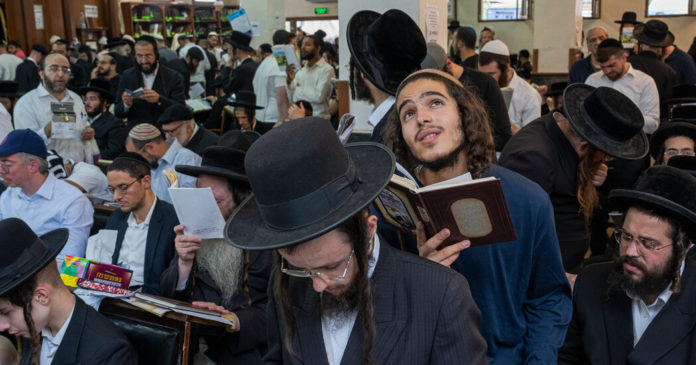Yosef Chaim Bernfeld, a young businessman from New York who is trying to clean up his life, journeyed to Uman this weekend for a “spiritual fix.”
Every Jewish New Year, even this one during a raging war, thousands of Hasidic pilgrims turn this city in central Ukraine into a mini Jerusalem.
They roam around in big groups sucking down Coke Zero and kosher pizza, paying in shekels. They pump out Hebrew hip-hop and dance hard together in the middle of the street.
They exchange blessings — “I ask God to give you a sense of belonging, to give you stability, to grow your business this year” — and drink copious amounts of red wine way past the wartime curfew.
Mr. Bernfeld, a sturdy 33-year-old who said he has struggled with his faith and substance abuse, has joined this gathering 11 times. But this year, he was clean, and his verdict was, “It’s different, maybe not quite as fun.”
But then his face lit up. “No man,” he said, “it’s amazing. It’s like a reset.”
This year, even Europe’s biggest war in generations and extensive travel warnings could not stop the pilgrimage. More than 35,000 people, nearly all of them men and boys, showed up over the weekend, upending stereotypes of Hasidic Jews who often cut an austere image with their black hats and long black coats. Many of the Hasidim who came to Uman came to party.
But Uman serves as a testament to something even deeper. Once a year, it becomes a thriving Jewish community in a place where Judaism was virtually wiped out.
The fact that one of the world’s biggest Jewish New Year’s celebrations unfolds in Ukraine, the site of some of the Holocaust’s worst atrocities, and in Uman specifically, where the Nazis gunned down a thousand Jewish children and threw their bodies in a pit, illuminates a resilience quite apt for the moment. It is the High Holy Days, after all, a time for joy but also painful remembrance.
“It adds meaning,” said Yitzy Gradman, another one of the many New Yorkers who flocked to Uman. “The biggest tribute I can give to the people who suffered here is to walk these streets today and say, ‘We are proud of who we are, and we will never be extinguished.’”
The Uman pilgrimage goes back more than 200 years. It is cemented on Rebbe Nachman of Breslov, who died in Uman in 1810 and was a great-grandson of the man widely considered the founder of Hasidic Judaism.
Rebbe Nachman was a deeply spiritual, charismatic figure in his own right. He encouraged people to show their happiness and commune directly with God, like a friend.
He asked his followers to be with him on Rosh Hashana, the Jewish New Year, and before he died, he promised that if even the worst sinners would pray at his grave in Uman, which is near Breslov, and give a little to charity, he would do whatever he could to save them from hell.
While Jewish tradition contains a variety of interpretations of the afterlife, Rebbe Nachman’s followers deeply believe in his power of salvation. Even during Soviet times, when organized religion was essentially shut down, Jews sneaked into Uman at the risk of being sent to the Gulag. After Ukraine gained independence in 1991 and religious freedom returned, the crowds at his graveside steadily grew.
The pilgrimage remains pious, but it is also wild. The Breslovers, as followers are called, are known for the exuberance with which they worship. Dozens have been arrested in Uman in past years for drug possession, drunkenness and brawling. This week, the Ukrainian police said that they confiscated illegal drugs from several pilgrims and planned to deport others for “aggressive behavior.”
But Breslovers are also known for being open-minded. Men in black hats and sidelocks prayed next to men in tight T-shirts and tattoos. Most came from Israel, with the second biggest contingent from the United States.
Before the war, a few even choppered in from Kyiv, the capital, about 120 miles away.
But now that Ukraine’s airspace is closed, most made overland trips from Poland, Moldova, Hungary or Romania that were long, exhausting and expensive.
“People put away all year for this,” said Mr. Bernfeld, who goes by Bernie. “But it’s beautiful. I don’t think I’ve ever seen so much unity.”
As a young man growing up in Rockland County, N.Y., Mr. Bernfeld said he chafed at the strictness of his Ultra-Orthodox community and turned to speed, cocaine and acid. It was not until he saw Rebbe Nachman’s followers dancing ecstatically on YouTube that he realized “there’s a fun Judaism, too.”
“It helped me immensely,” he said. “It might have even saved my life.”
He recently moved to Israel, and on Friday night, he was kicking back with fellow Breslovers in a tent laid with a feast: plates of salmon and baked chicken, vegetable broth, salads, fried potatoes and hunks of freshly baked redolent challah that they dragged through bowls of thick Ukrainian honey.
The pilgrimage lasts about a week, and while there are some scheduled events, it is a lot of hanging out and breaking bread.
During the day, pilgrims circulate on Pushkina Street, the main drag in Uman’s tiny Jewish neighborhood. They look for friends they have not seen since the last pilgrimage, visit rabbis for blessings, listen to motivational talks and squeeze into the small building housing Rebbe Nachman’s grave. The smell of sweat, pizza grease and cigarette smoke hangs in the air.
At night, music blares from speakers and men throw their arms around each other and turn Pushkina Street into a dance floor. Later, they retreat to rented apartments to uncork beverages. Even after the midnight curfew, loud music — and loud laughter — wafts through open windows across town.
Locals are not sure what to think. Before the Holocaust, half of this city was Jewish. Today, out of 85,000 people, only a few hundred Jews are left. More than 2 million Jews once lived in Ukraine. Now it is around 200,000, perhaps less, though one of those, Volodymyr Zelensky, is president.
Mr. Zelensky didn’t stop by Uman this week but a small contingent of Ukrainian Jews joined the festivities, which have fueled a bustling economy. Entire 10-story buildings are hired out, taxi drivers get dream fares and vendors do a mean trade in T-shirts, books, amulets and other Breslov merch.
Officials at city hall said the pilgrimage brings in more than $20 million a year, and businesspeople are clearly grateful. Still, some residents do not like it.
“There’s disorder in our city because of all this,” said one resident, Natalia Hordiyenko.
“I have nothing against them,” she added. “They came here to celebrate their religious holiday. We understand all that.”
But then Ms. Hordiyenko lit into the pilgrims for leaving behind “horrifying” amounts of litter and making unwanted advances on women, saying, “They misbehave.”
Resident-pilgrim relations is a rich topic. Some pilgrims complained equally bitterly about the Ukrainians, accusing them of being cold and suspicious.
One of Mr. Bernfeld’s friends proposed at the dinner table that Rebbe Nachman’s grave should be excavated and flown to Israel. It sounds far-fetched, but the Israeli government has lobbied to do exactly that.
“It’s an embarrassment we’re even here,” said Shlomo Ettlinger, an accountant, as he put down his glass of wine. “Why are we having this event in a town where Jews were massacred not once, not twice, but many times? Being here is like an abused person going back to their abuser.”
Another man at the table laughed. “So, what are you saying, Shlomo?” he asked. “People don’t like us? Tell me something new.”
Mr. Bernfeld then stepped in, saying, “Shlomo, you know how much I respect your opinion.”
He dragged another hunk of challah through the honey and chewed thoughtfully.
“But Rebbe Nachman said challenges are important, and it’s a challenge getting here,” Mr. Bernfeld said. “And more than that, I like this vibe. I don’t want to change it.”
Oleksandra Mykolyshyn contributed reporting from Uman.
Source : Nytimes











